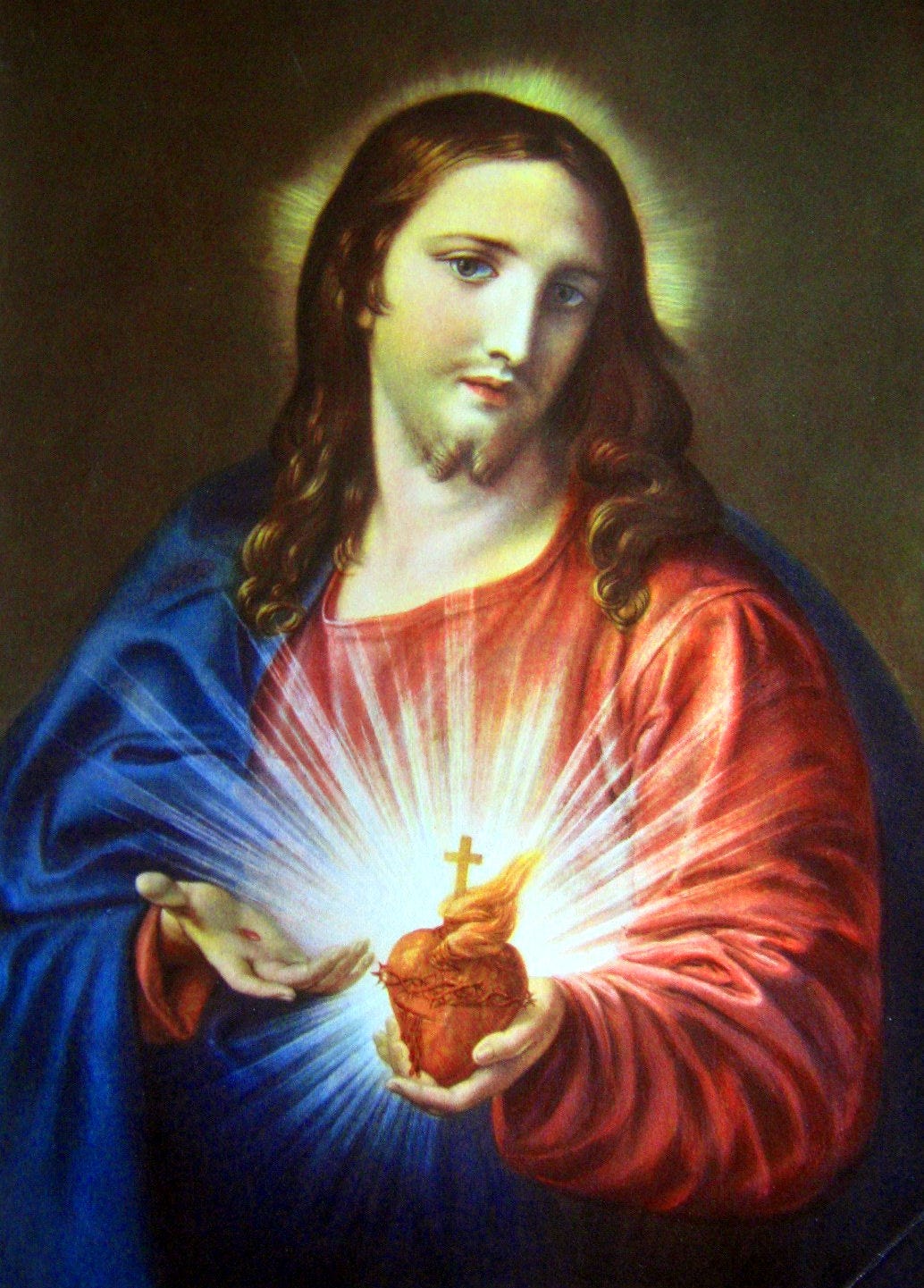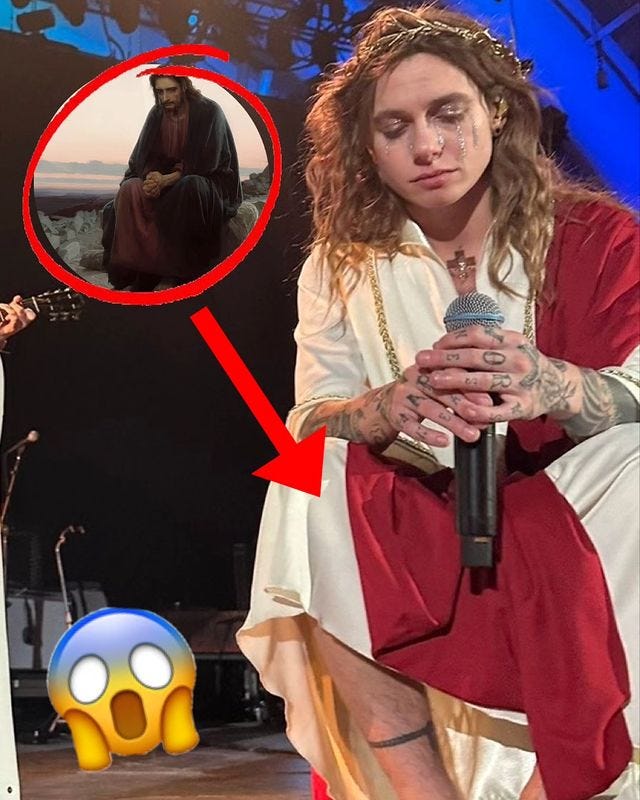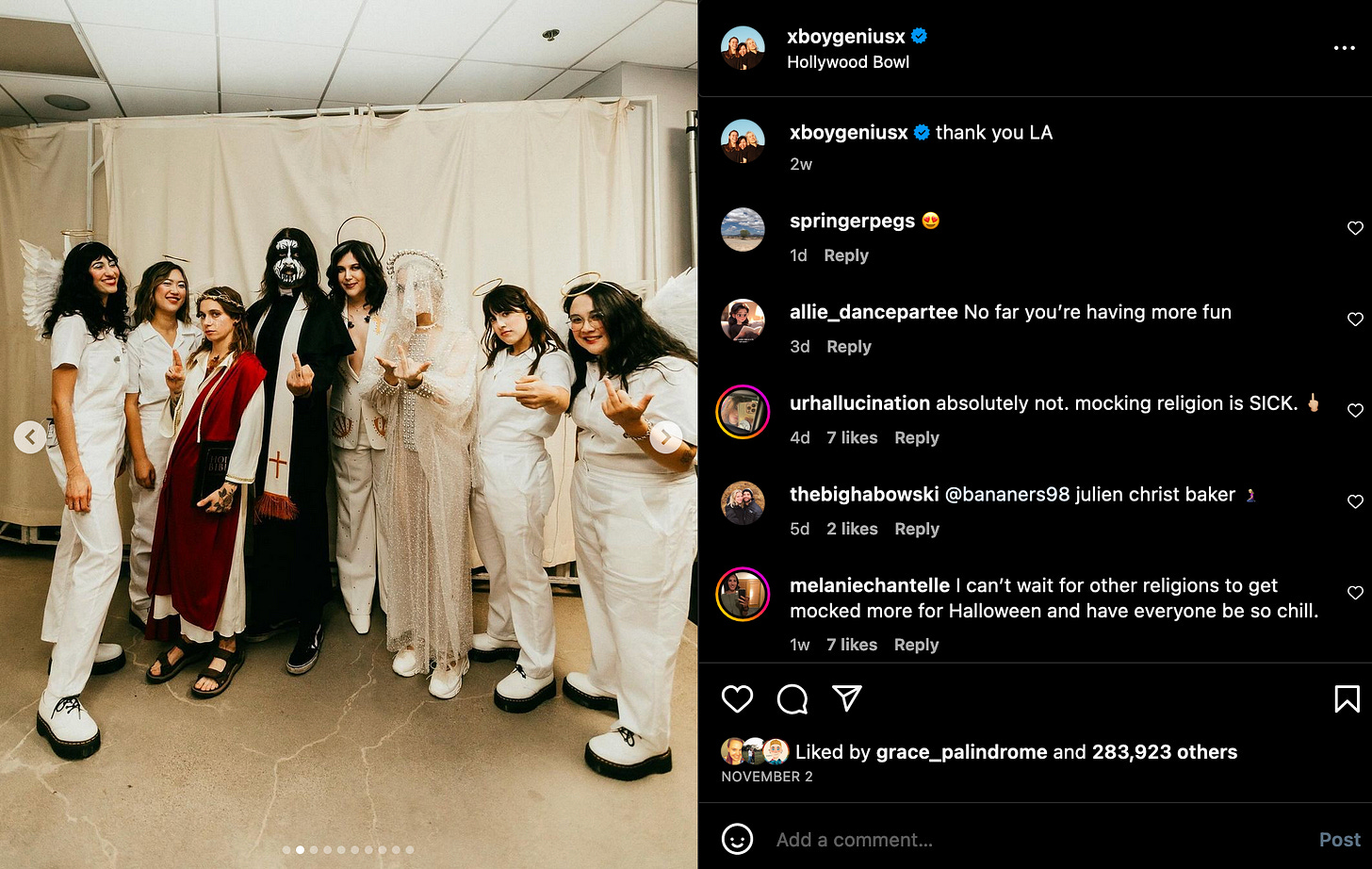boyjesus: Iconography at the Hollywood Bowl
Always an angel, never a god?
On October 31st, 2023 at the Hollywood Bowl in Los Angeles, the Father, the Son, and the Holy Spirit appeared before a crowd of thousands. With a choir of angels behind them, they gave an unforgettable finale to an unapologetic summer tour that skyrocketed them into the mainstream, giving the cheekiest answer to their creative challenge to one another: what would the boy genius do?
Lucy Dacus, Julien Baker, and Phoebe Bridgers have leaned into the provocative with their latest boygenius tour, but dressing as Christianity’s Holy Trinity is probably the most feather-ruffling thing they’ve done. Unsurprisingly, it broke through their core audience and reached the Christians whose theology compels them to see these costumes as grievous offenses that cannot be beheld for longer than five seconds. In plainer terms, people got offended.
Me? I was delighted and fascinated. In undergrad at my Christian college, I took an iconography class that spanned from the Byzantine Empire to modern film and music videos. Since then, I’ve been drawn to these moments when Christianity intersects with pop culture, whether that intersection is supportive or critical of the faith, or downright blasphemous. I’m not a minister or considering ordained ministry. I’m not a formal theology student. I’m a writer who grew up non-denominational (Evangelical) and has spent the entirety of my adult life thus far in a progressive Christian tradition.
To that end, I’m not interested in convincing you to not be offended. Peace be with you if you can only envision this moment as a heretical evil done by abominations, but I’m not here for that. This essay isn’t here for that. As we’ll see especially when we get to Julien Baker’s Christ costume, this is a powerful declaration that queer people do have a place in a faith filled with those who reject them.
What is Christian iconography?
“Those who venerate the saint or Savior of popular images bring broken bodies to be mended, shattered nerves and sick children to be healed. The body of the believer is explicitly engaged in what we may call the visual piety of popular religious images.”
-David Morgan, Visual Piety: A History and Theory of Popular Religious Images
To ground ourselves in considering boygenius’ costumes, we first need to understand what Christian iconography is, its purpose, and its use in various Christian traditions. Different answers to these questions explain why some Christians will balk and immediately dismiss these costumes while others may embrace them. The class I took in college informs my own view of iconography and one of the key texts I read in that course was Visual Piety: A History and Theory of Popular Religious Images by David Morgan. This book really helped me understand and appreciate iconography, especially since I’d grown up in a Protestant context where iconography wasn’t common.
Christian iconography typically refers to any visual art that depicts figures and scenes of the Christian faith, and plays a role in a Christians spiritual life. I would extend this to include written and auditory arts. Icons such as The Last Supper and Sacred Heart are often used as focal point during prayer and contemplation. The scene or figure depicted in the icon is a tangible way for the viewer to consider the eternal, intangible God. The icon becomes a window or pointer to God/Christ/etc. It is not holy in and of itself. This is key because, historically, Christians have acted like the depictions themselves are truly what Jesus, the disciples, and other figures really looked like, which leads to rejection of, say, Black Jesus.
Throughout history, Christ icons in particular have shifted to reflect the cultures in which those icons are used. In one of the lectures in my iconography class, the professor had us study two prayer candles depicting Sacred Heart. One was created and sold in Europe, the other in Latin America. Looking at them side by side, you could see subtle differences. Both Jesuses (Jesi?) were white, but the European Jesus was noticeably paler. He also looked skinnier and the heart was smaller. Meanwhile, the Jesus in the Latin American icon was a darker shade of white with dark hair, a fuller build, and a larger heart.

While Christian icons may shift depending on culture, the white European depictions are the most ubiquitous due to colonialism. Combine this with the Christian tendency to venerate this depiction as the only appropriate one, despite iconography’s purpose in being the sign vs. the signified, and we have the ingredients for a visceral, offended response to icons outside of these bounds.
There are also key differences in how Catholics, Orthodox Christians, and Protestants relate to and use iconography. Generally, Protestants have a lower view of iconography than their Catholic and Orthodox counterparts. Many Protestant churches have little to no artwork depicting human biblical figures or events. To be sure, there are Protestant icons–The Head of Christ being the most prominent. But iconography doesn’t occupy as high of a place in Protestant spiritual practice. Some Protestants who view Catholicism as idolatry may associate high amounts of iconography in church or in the home as venerating graven images. At the same time, they may recoil at critical, satirical, provocative, and crass icons because there is still this strong sense of appropriate vs. inappropriate ways to depict Christ and other biblical figures.
Catholics and Orthodox Christians, on the other hand, generally have much more iconography in their churches and perhaps in their homes. So whatever depictions surround them also give them a sense of appropriate and inappropriate representations, especially since such art is more strongly connected to their spiritual practice. Therefore, no matter what flavor of Christianity we’re talking about, we can internalize ideas of right and wrong ways to depict holy figures. If a figure is depicted in a wrong way, we are certain its message about that figure is wrong.
Sacrilegious iconography, which can include any depiction that criticizes or satirizes Christianity, was presented to me as something done to bully Christians, to be offensive in a shallow, edgelord way, but to have nothing substantial to say about God or faith. It was to be feared, fought, and rejected. But I’ve since found that not pearl clutching at sacreligious iconography provides an opportunity to see something profound about God that you might’ve missed by looking away too quickly.
I’m not sure that I would classify boygenius’ Halloween costumes as sacrilegious, but many would. So now, let’s turn to understanding what this band is about and how each of its members relates to Christianity (or not).
The conceit of boygenius
Three queer female musicians form a supergroup and call it “boygenius.” Why boys if they’re women? On the surface, it’s a funny joke, but there’s an intentional social statement behind it. The trio is satirizing the degree to which art created by men is lauded as genius and revolutionary, even if it’s mediocre. Specifically, they’re poking fun at a type of man they have often encountered in the music industry who is not only highly praised for his work, but behaves as if his every thought is a masterpiece. As the band writes songs, they challenge and encourage each other by saying, “do what the boy genius would do.” A boy genius would think that this line or that riff is artistic perfection–it’s a corrective measure to the way women often internalize the message that nothing we create is good enough. Additionally, “fuck[ing] around and find[ing] out” about gender comes with the territory of being queer.
Therefore, all of their public stunts as a band can be seen through this lens–if the male rock stars can rip their shirts off at shows, so can boygenius. If the male rock stars can be praised for a “fuck authority” attitude, so can boygenius. And if the male rock stars can think of themselves as God, boygenius can dress like God.
boygenius as the Holy Trinity
“…no sign is adequate to the divine…”
-David Morgan, Visual Piety: A History and Theory of Popular Religious Images
At the Halloween show, Lucy Dacus dressed as God, Julien Baker as Jesus, and Phoebe Bridgers as the Holy Spirit. This is not the first time any of them have incorporated religion in their art, but it’s a rather blatant and, to some, shocking instance.
I don’t want to dwell much on their personal lives or beliefs. I certainly don’t want to deify them because that’s weird on a multitude of levels. However, each band member’s relationship or lack thereof to Christianity is an important part of understanding the iconography of the Halloween show. I must thank my friend Hannah for summarizing the trio’s backgrounds for me.
Lucy Dacus, the Father
Lucy is adopted and grew up in Virginia with an Evangelical family. She’s not a Christian, as she decided to turn away from faith, but she may be agnostic. She deals with matters of faith both in her solo work (which as of this writing I have yet to get acquainted with) and in some of her boygenius work. For instance, one of her lines in “Satanist” goes “Solomon had a point when he wrote Ecclesiastes/If nothing can be known, then stupidity is holy.”
So, her costume is God, the Father. She has a white tailored suit embroidered with lightning bolts and a fan or sea shell design. Behind her head is a halo. Several readings come to my mind considering this outfit.
In “Not Strong Enough,” one of the huge singles off the record, Lucy leads at the bridge, which is “Always an angel, never a god.” The choice to dress as God is a delightful play on this line.
Despite the fact that, theologically, calling God “Father” is meant to invoke a relationship and not gender, many Christians who speak languages that have few options for gender neutral designations don’t learn this without studying theology in some form. So, we project maleness onto God as an essential quality instead of a relational quality. Lucy chose a suit, which projects masculinity even though in U.S. society, women have been wearing suits for decades. The sight of a woman in this suit dressing like God prompts those of us looking at her to question our assumption of God’s gender. Why do we need to believe that God is only male when we hold that all people are all created in God’s image? If God is only male, then all humans as imago dei could only be male, but obviously other genders exist.
The lightning bolts have a clear association to the idea that God smites sinners. We imagine an angry old white man in the sky casting lightning down on wicked cities. However, the embroidery may also allude to Roman mythology, especially since the seashell/fan pattern looks like the seashell from The Birth of Venus. So maybe there is this play with the Christian God and Roman gods.
The halo is a common feature in Christian iconography and is used to identify Christ, Mary, the disciples, and various saints. If you’re looking at traditional Christian art and someone has a halo, you can assume that they fall into one of those categories. Although God isn’t depicted in art as often as Jesus, the halo does appear in many cases. Because the halo is a symbol of holiness, and we’re seeing a queer woman wearing one while dressed as God, we’re invited to question our ideas of when/where we recognize the imago dei in others.
Feelings of shock, anger, or disgust when looking at this outfit occur because of the clash between what it’s provoking us to consider about God and the way that we’ve been taught to glorify the essential maleness of God. Feelings of joy, delight, and affirmation occur if we take seriously the idea that God is not bound to the confines of one particular human gender.
Once again, Lucy is not a Christian. She may not have intended all these readings into this outfit choice. Maybe to her it’s a funny joke. If it is, that’s okay. Many Christians are reviving the celebration of Holy Humor Sunday, observed the Sunday after Easter, which puts laughter back into our often morose religion. Also, while to Lucy and Phoebe these costumes may be more of a joke, they likely understand that to Julien, it’s a little more serious.
Julien Baker, the Son
Julien Baker is from Tennessee and has been in and out of Christian faith at least since start of career. Of the three members of boygenius, Julien is perhaps the most overt in dealing with belief and disbelief. She gets bonus points from me because she’s a mewithoutYou fan.
The world does not make it easy to be queer and Christian; sadly Julien has struggled with addiction and self-hatred because of this dichotomy imposed upon her.
This queer, recovering addict dressed as Christ.
The part of the show where they introduce their backing band and their costumes begins as a joke. Then, Julien makes it a touch more sincere. Her exact words, in a humorous, awkward tone, are: “Remember that Christ is an image of brotherly love that you’re allowed to inhabit. And supposed to–anyway…everyone can be Christ, if you want to.”
She sounds anxious as she tries to cram a theological statement into thirty seconds before thousands of fans who want to love everything she says and does. All this while keeping the tongue-in-cheek vibe of the show. It’s actually quite authentic and vulnerable. She senses the importance of the iconography she’s creating with her bandmates, even while embracing the silliness of it.
Let’s consider this outfit.
As a white woman with brown hair, it’s an obvious choice for Julien to depict white Jesus. She’s also wearing a crucifix, a crown of thorns, and glitter tears, so she is specifically invoking Jesus’ suffering on the cross. Julien likely did not consciously attempt to mimic specific paintings of Jesus (and the photographer may or may not have intended it with this shot), but I’m sure it happened a bunch of times anyway.
Note Julien’s hands in this photo. The raised fingers appear in numerous Christ icons and generally represent a blessing, the human/divine nature of Christ, and/or the Trinity.
Here, we see part of a sacred heart tattoo on Julien’s chest. Since she’s so heavily tattooed, I’m not sure if it’s permanent or temporary for the sake of the costume. We also see part of her three of cups neck tattoo. Though that image is from tarot cards, it’s depicted here as three chalices and chalices are also a common symbol in Christian art. Many Christian icons depict Jesus holding a chalice, particularly during the Last Supper. Lastly, the angle and colors in this photo are quite similar to Warner Sallman’s famous Head of Christ that I mentioned earlier.
This is a nice shot of Julien’s rainbow guitar strap. It’s a common find at Guitar Centers everywhere, but the juxtaposition with Julien’s Jesus outfit creates a powerful symbol. Straight Christians and non-Christian queer people often perpetuate the idea that one cannot be queer and Christian, but this symbolism invites those who dare to look to question that belief and the road that led them there.
The glitter tears are an interesting element. They remind me of glittery ashes that I’ve encountered in the United Church of Christ and in other churches on Ash Wednesday. In that context, the glittery ashes are stardust to remind us that we were formed from stardust and to stardust we shall return. The glitter adds awe and whimsy to mortality, which can be helpful in dealing with it. Julien’s addition of glitter tears to her portrayal of Christ reminds us both of Christ’s suffering and of the coming victory of the resurrection.
Glitter is also strongly associated with the queer community, especially gay men and drag performers. By wearing it as tears, this Christ icon that Julien is depicting ties queer suffering to Christ’s suffering, reminding us that Christ weeps with those who weep, including the maligned LGBTQ+ people.
“Unpackin’ God in the suburbs”
Although all boygenius songs are boygenius songs, some proceed predominantly from one of the three (bad and vaguely heretical trinitarian pun intended). On the record, “Anti-Curse” is mainly a Julien song. She based it on a near death experience she had at the beach where, despite Phoebe’s warnings, she went out too deep and almost drowned. Such an experience naturally lends itself to reflections on faith and doubt, and we find that in this song. In verse one, the narrator sets the scene and makes peace with death. Then, in verse two, we get this:
There we were
Was anyone ever so young?
Breakin' curfew with illegal fireworks
Unpackin' God in the suburbs
I'm swimmin' back
This is a memory flashing through the narrator’s (Julien’s) mind. The vocals pause after “unpackin’ God in the suburbs,” and there’s a build up of musical tension that explodes at “I’m swimmin’ back.” The narrator has gone from drowning–from accepting death and having their last thought be this memory of talking religion with, presumably, a close friend–to swimming back to shore, continuing to live.
There are so many parallels to make here with Julien’s personal and spiritual life. “Anti-Curse” is a resurrection song and that element of it is made even more salient by performing it in her Jesus costume.
“Will you be a Satanist with me?”
With the amount of thought Julien put into this costume, we’d be remiss not to examine the irony of her wearing it while singing “Satanist” at this show. It was part of the setlist at every show on the tour, so it’s not the case that the band decided to play it at the Hollywood Bowl because of their Halloween costumes.
The title alone is provocative enough, and then the first verse, which Julien sings, begins with “Will you be a Satanist with me?”
Pretty shocking, since I think even some nonreligious people have internalized a fear of Satanism, largely due the Satanic Panic that peaked in the 1970s-1990s. Others embrace it because it’s edgy and subversive. So, if you have an icon of Jesus singing this song, how is it anything but mockery?
Maybe it is mockery. Maybe it’s rude and offensive. Even if it is, I think there’s still more we can come away with beyond that, especially when we look at the entire song.
Will you be a Satanist with me?
Mortgage off your soul to buy your dream
Vacation home in Florida
The collateral the Devil's repossessin' from me
Tryin' to score some off-brand ecstasy
Satanist is capitalized because it’s referring to the religious/activist group, The Satanic Temple, which inspired this song. A 2019 documentary about this group describes it as a sarcastic publicity stunt that then became a movement in support of religious pluralism, reproductive rights, LGBTQ+ rights, and the separation of church and state. They criticize Christianity’s ubiquity in government policy and public buildings.
Yet in this song, Satanist is defined in the spiritual sense, with a mortaging of the soul for material gain. Despite the invitation to become a Satanist, the consequences aren’t that glamorous. Adding Julien’s portrayal of Jesus on top of this gives us a Christ who is criticizing the pursuit of material wealth at any cost. I’m reminded of the Gospel account where Jesus is fasting in the desert for 40 days and the devil tempts him. One of those temptations is having dominion over all lands, something that, in our world, the wealthy can do by owning vacation homes. Jesus resisted this temptation and criticized the wealthy, yet so many American Christians subscribe to the prosperity gospel. We have megachurch pastors who probably do have vacation homes in Florida. Christians who earnestly believe in the prosperity gospel are likely to consider white European Jesus to be the true way to depict him. So, Julien portrays white European Jesus singing this verse–the “comfortable” image of Christ inviting the listener to be a “Satanist,” a person who sells their soul for material gain. It’s hanging a lantern on how wealth and Christianity are intertwined.
The rest of the song continues this pattern of inviting the listener to wear a shocking, edgy identity (anarchist, then nihilist), but then suggesting that the tennents of that identity aren’t that great.
The anarchist verse, sung by Pheobe Bridgers, gives the invitation (“Will you be an anarchist with me?”), an edgy activity related to that identity (“Sleep in cars and kill the bourgeoisie”), then reverses any perceived glory in that identity (“At least until you find out what a fake I am”). Although Bridgers’ is referencing a reaction she received to one of her live performances, what this verse adds on its own to the song is this questioning of authenticity when adopting provocative religious or political beliefs.
Lucy Dacus’ nihilist verse is less critical, but since it’s the last of these verses that begin with an invitation, we can read it as the song narrator’s landing spot. First, they begin identifying as a Satanist. When that falls through, they move to anarchism. When that is still inauthentic, they arrive at nihilism.
Just as there’s an added layer of irony with Julien dressed as Jesus singing this song, so too is there irony with Phoebe and Lucy singing their verses with their costumes. The Holy Spirit is singing about anarchism; the Father is singing about nihilism.
Other songs that boygenius performed that night play off their costumes in fascinating ways, but in the interest of my sanity, I need to move on. Let me know if you’d like to read another essay going more in depth on the juxtaposition between the Trinity costumes and the set list.
Is this a joke?
Of the three costumes, Julien’s is the least likely to be a pure joke. Is there humor in it? Absolutely. But I also think she’s reclaiming her own suffering and letting her faith hold some of it.
She also uses the costume to directly challenge purity culture in what is perhaps the most provocative and heretical photo posted online.
“For God’s eyes only” is a common refrain that’s used in purity culture to encourage abstinence. Having this phrase on a pair of underwear invokes chastity belts and other measures to scare young people, particularly young women, away from sex until they’re married, and then they’re suddenly expected to be okay with sex.
This photo is provocative for several reasons and heretical for one. Jesus having underwear and flashing it; Jesus having sexuality at all; and of course Jesus being portrayed by a queer woman. All of this makes the photo provocative, but what makes it heretical?
The fact that Phoebe Bridgers, as the Holy Spirit, is not looking at Julien’s underwear.
Lucy, dressed as God, points to the underwear while smirking at the camera, so technically she isn’t looking either, but the implication is that, as God, the underwear are for her gaze. Meanwhile, Phoebe covers her eyes, but when dressed as the Holy Spirit, she shouldn’t be. If the underwear is for God’s eyes only, but only God the Father is looking, then the photo suggests that the Holy Spirit is not God and that’s a heresy.
Phoebe should be looking.
Phoebe Bridgers, the Holy Spirit
Phoebe Bridgers is an atheist, but she grapples with religion in several tracks of her most recent solo album Punisher. “Chinese Satellite” (my personal favorite) and “I Know the End” are some of the most overt. Even though she’s definitely not a Christian, she’s thought a lot about faith, judging from her work. This plus her friendship with Julien is why I’m not inclined to see Phoebe’s costume or any of the costumes as insunbstantial mockery.
Phoebe’s choice to dress as the Holy Spirit makes sense given that she uses ghost, skeleton, and death imagery in her solo work. A ghost depicted as someone wearing a bedsheet is an iconic image from her debut album Stranger in the Alps.
However, if I didn’t see this costume in context with Lucy’s and Julien’s, I wouldn’t have guessed that it’s the Holy Spirit. In most Christian iconography, the Holy Spirit is portrayed as a dove, but the only clues in this outfit are the halo and the all white color palatte. Phoebe went with a ghastly, sparkling look and it’s a great outfit. It just doesn’t play much with existing iconography and it doesn’t have to. For Phoebe, I mostly see this outfit as a choice to match her general vibe as an artist. Even her voice often sounds haunting.
The Holy Spirit is most strongly associated with Jesus’ baptism and Pentecost, the event in the book of Acts where thousands were converted to Christianity. Additionally, the Spirit is known as the advocate that Jesus promised to the disciples after his ascension into heaven. In many Christian traditions, the Holy Spirit is considered to be the one who spurs a Christian’s salvation. The Spirit is also the one who guides a Christian’s life and convicts them.
Perhaps the one thing we can glean from Phoebe’s Holy Spirit costume is the irony. On one hand, we have what the Holy Spirit does and represents, and on the other, we have Phoebe. She is certainly deified by some of her fans (as are Julien and Lucy), and that has turned toxic at times. In fact, boygenius has a song called “Bite the Hand” that’s about the fraught, parasocial relationship that their fans form with them. Some of the unhinged fan behavior at shows may well be interpreted, in an odd way, as Pentecost-like. At Pentecost, people appeared drunk and possessed, and with Phoebe being the most famous of the boygenius trio, she’s had that effect on people.
But Phoebe is human, not God, and probably the healthiest way to look at this costume is that it makes us confront the degree to which we see artists and celebrities as gods. How much do we let our fanaticism for their creations possess us, making us expect holiness and perfection from them?
boygenius, perichoresis
There are two main representations of the Trinity that appear in Christianity. One model most associated with Catholicism and Protestantism is an equilateral triangle with the Father on top and the Son and Spirit on the sides. Although we’re meant to understand the names of the persons in the Trinity as relational, what often happens with this model is that we internalize a hierarchy.
The other model, often associated with Eastern Orthodoxy, depicts the Trinity as a circle where the three persons dance around each other in perichoresis. This emphasizes the relational aspect of the Trinity and lessens the tendency to see any hierarchy among the three persons.
This is an extremely simplified explanation and if you’re a theology expert, sorry. My point in mentioning this is that, if we’re going to look at boygenius as an icon of the Trinity with these costumes, what they’re representing about God is perichoresis–you can hear it in any interview they do. None of them is the head over the other two and the love they have for one another is shared equally among all three of them. Not to mention that, being musicians, there’s the literal dancing around each other that they do on stage.
The band’s quickness to display the lack of hierarchy and ego among them is what makes their public antics easy to interpret as artistic satire. Listen to or read any interview with them and you’ll quickly find that they don’t actually hold the inflated mindset of the type of man they’re criticizing. The “boy genius” character would absolutely think of himself as a rock god, dressing and behaving as such, but unironically. He would be arrogant enough to equate himself with God’s greatness. That’s a central part of the playfulness of these costumes.
Halloween as Gay Christmas
A 2023 article by Oliver Haug at Them magazine explains the history of how the queer community embraced Halloween throughout the 20th century. Halloween and other carnivalesque holidays provide socially acceptable spaces to break societal norms, including those around gender and sexuality. This was a lifeline, especially in prior decades when the criminalization of queerness was more institutionalized than it is today. Whereas Christmas in Western countries is typically a time to gather with family, and for many LGBTQ+ people, a time to go back into the closet, Halloween gives permission for queer people to be less guarded and celebrate among accepting loved ones. Many Christians who reject LGBTQ+ people also reject Halloween.
And yet, Hallowtide is a Christian liturgical season–Halloween on October 31st, All Saints Day on November 1st, and All Souls Day on November 2nd. Like Christmas, it’s become commercialized, but it has a long history in Christian tradition. I find it poetic that a people marginalized by Christians finds joy and celebration in a holiday also marginalized by Christians.
With this in mind, three queer women in a band dressing as the Holy Trinity for a Halloween show carries another layer of significance. They may or may not be cognizant of this history, but the symbolism is there nonetheless. God is everywhere and in everything, including our jokes, our satire, and people we deem as abominations. God appears in unexpected forms through unexpected people, and if we choose to look away in our righteous indignation, we may miss out.
What stirs righteous indignation and why?
Some of the comments in the screenshots I used for this essay are angry, asking why the band has to mock Christians, or criticizing Julien for dressing as Jesus while there’s a genocide in his homeland, Palestine. Never mind that Julien and Lucy were photographed at a free Palestine rally, and Phoebe has shared several non-profits aiding Palestinians on her Instagram stories.
It’s true that this Halloween show didn’t happen in a vacuum. Nothing does. I’ve already explained that I see far more in these constumes than shallow, edgelord mockery. But I do wonder about Christians who expend their righteous indignation on these costumes while a group of marginalized people in Jesus’ literal homeland are facing genocide. As people of faith and human beings with finite energy, where are we going to focus our anger in the name of Christ? If three queer women dressing as the Holy Trinity at a rock show stirs righteous indignation, why?
Ultimately, you may conclude that these costumes are crass and offensive and nothing more. I cannot convince you otherwise. I can only explain what I see when I look at them, and what I see is a beautiful opportunity to examine our deepest help beliefs about God.
If you enjoyed this essay, consider tipping me on my ko-fi page.
Credits and Links
Donate to Palestinian Children’s Relief Fund.
Full playlist of the Hollywood Bowl show.
Screenshots and Instragram posts are from the following accounts:
@ jrb.memes (Julien fan account)
@ juliensmoth (Julien fan account)
@ boygeniussource (fan account)
@ lucydacus (Lucy’s official account)
@ phoebebridgers (Phoebe’s official account)
@ xboygeniusx (offical band account)
Texts and artwork mentioned:
Note: I mostly linked to Wikipedia articles because they’re most likely to explain Christian theological concepts in a measured, non-proselytising way. I don’t want to send readers to church websites that may espouse harmful theology.

















